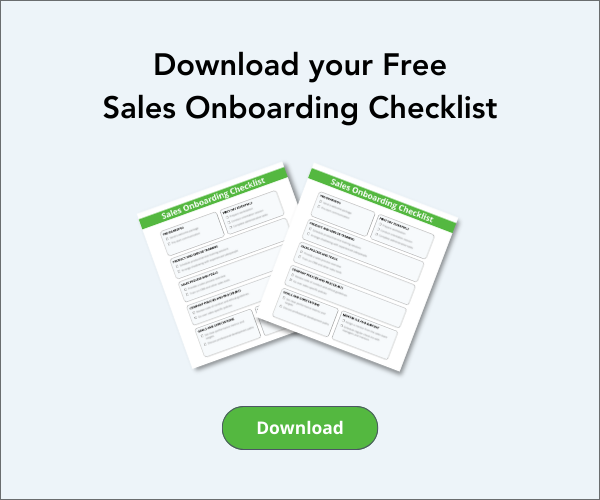
Onboarding new salespeople is a vital aspect of the success of any sales organization. After all, the salespeople are at the heart of everything you do. Turnaround is inevitable in such a fast-moving industry, and even the most loyal reps can be tempted away with a better offer elsewhere, or simply because they’re looking for a change of place.
And if business is booming, then expansion is inevitable, and bringing new hires on board is going to be a crucial part of maintaining your organisation’s pace.
So when the time comes to assimilate new salespeople into an existing sales structure, it’s important that you have all your ducks in a row. The last thing anybody needs is unnecessary friction slowing everything down or potentially harming productivity.
That’s why we’ve decided to put together a comprehensive guide to onboarding new sales hires. Perfect for growing organisations or huge, well-oiled machines, the following tips should ensure the process is as smooth and stress-free as possible for all concerned.
At the end we’ll even throw in a free downloadable sales onboarding checklist to take the hassle out of your onboarding experience.
Without further ado, let’s dive in!
Broad Strokes
As much art as science, the process of sales onboarding is something that can be developed over time. Very few people are able to nail it on their first attempt, not least because it demands such a careful blend of structured training, mentorship, and hands-on, practical experience.
The goal, of course, is not only to make your new hires as productive as possible, but also to make sure they feel valued as part of your business. Happy, respected sales reps are the secret sauce behind every successful organization, and there’s no better way to get such an important relationship started off on the right foot than by nailing the onboarding process.
A further benefit of solid sales onboarding is a reduction in short-term turnover. Nothing tastes worse than training a new rep for a few weeks, only for them to turn tail and leave once you begin to feel they’ve settled in. By locking down your sales onboarding practices ahead of time, you stand a great chance of preventing this unpleasant situation from ever occurring.

Step 1: Pre-Boarding
Onboarding doesn’t actually start on Day One. There’s plenty of work to be done before the new hires ever clock in to make sure you’re setting up the relationship for success. The last thing any recent addition to the team wants is to feel they’re working with a disorganized, slapdash manager who doesn’t have all their i’s dotted and their t’s crossed.
Here are a few steps you can take before the first day to make your new team members feel welcome and excited about their role.
Welcome Package
A welcome package that includes company swag, an introductory letter, and any necessary paperwork might sound like a lot of effort, but it goes a seriously long way. Compared to previous employees who might not have taken the time or energy to put together such a package, you’ll already be marking your organization out as different, which is a lasting first impression your new hires won’t forget in a hurry.
After all, who doesn’t like feeling a part of the team before they even clock in?
Pre-Start Communication
Everybody’s nervous on their first day, no matter how experienced or self-confident they are. A few encouraging words from their prospective manager can make a world of difference when it comes to assuaging those pre-game jitters.
It doesn’t have to take up a huge amount of your time, but sending off a friendly email a couple days before they’re due to begin is often an excellent way to get the relationship started off on the right foot.
Step 2: First Day Essentials
The first day for your new hire should be all about making a great first impression and setting the tone for the course of their tenure with your organization. Don’t stress too much about productivity or nailing each and every minor detail. It’s better to keep the focus on creating a welcoming, well-organized environment that inspires confidence and trust from the get-go.
Here are a few simple tips that might seem minor but are guaranteed to be noticed by your new team member:
Welcome Aboard
Make sure their workstation is clean, well-equipped, and ready to go. It’s also never a bad idea to have a team member greet them upon arrival. Nobody likes showing up to a party where they don’t know anybody, and starting a new job is no different.
Orientation Session
This one is vital. An orientation session that provides an introductory overview to the company culture, history, and mission will equip the new rep with everything they need to slot right into your organization. It doesn’t need to last forever—and it’s probably better if it doesn’t—but even twenty minutes can be enough to make a difference.
Admin Essentials
Admin details are like pots of soup: if you leave them on the stove too long, they’ll burn. Don’t leave any of the essential administrative tasks to simmer on the back burner. From setting up email accounts and access badges to dialling in payroll details, getting everything out of the way will ensure a smooth transition into working life for the new worker.
Step 3: Product and Service Training
Now that the initial stage of the sales onboarding has been completed, it’s time to dive into the nitty-gritty. In-depth knowledge of the products or services your company deals in is absolutely fundamental to a strong sales performance.
Training Sessions
Training sessions are the cream of the crop as far as employee training goes. By conducting detailed presentations in person, you’re giving the new hire a chance to ask any questions that arise, rather than having to figure them out on their own and potentially make mistakes. Aim to cover the features and benefits of your products and services, as well as some details about your target market, and try to ensure the session is as interactive as possible.
Shadowing
There’s no better way to learn than by watching more experienced operators do the same job you’re going to be doing. For the initial period of your new hire’s time with your team, allowing them to shadow some of your more seasoned veterans as they go about their daily duties can be a fantastic, hands-on education. Of course, it’s important to check with the relevant team members to ensure they’re okay with being shadowed.
Step 4: Sales Process and Tools
No two sales organisations are alike. Although they all have the same mission—effectively selling products or services—every single company goes about the challenge slightly differently. Any new hire will probably have learned a few different processes throughout the course of their career, assuming it’s not their first ever position, so there may be a few initial friction points.
But don’t think of it as something to ‘untrain’ or ‘unlearn’. Rather, aim to gently show them the ropes and make them feel like you’re investing in their ongoing success with your team.
Sales Process Overview
As a jumping-off point, offer a clear, high-level overview of your sales process. The key areas to focus on include stages, key activities, expected outcomes, and KPIs. Don’t leave any stone unturned here. The goal is to be as clear as possible about what will be expected of them and how they’ll be evaluated, so they can know for themselves exactly what their role is going to look like.
CRM Training
Even if they have experience with the same CRM software your organization uses, it never hurts to have a refresher course, since instances of the same program can vary hugely from company to company. And if they haven’t used the software before, any time invested in training them on the system will pay dividends in the long run. CRMs are the cornerstone of every successful sales team, after all.
By the way, if you’re looking for a lightweight, user-friendly CRM that new hires can get up and running with sooner rather than later, why not check out noCRM? You can learn more about how suitable it is by clicking here.
Step 5: Company Policies and Procedures
While you’ll probably have already covered this to some degree in the orientation session, it never hurts to go into a bit more detail about the most pertinent company policies and procedures your new hire will have to get to grips with during their employment. This doesn’t have to be as dull or bureaucratic as it can sound.
It’s really just a question of reviewing the most important points and making sure everybody’s on the same page to reduce the likelihood of any potential misunderstanding.
Code of Conduct
You don’t need to spend too long on the code of conduct. These guidelines tend to be similar from one company to the next, so it’s probably not new information to your recent addition. Be sure to review the ethical guidelines, reporting structures, and compliance regulations, but beyond that don’t feel like you have to get into the nitty-gritty of every single point.
Sales Policies
It’s worth investing more time in going over your sales policies. Going over sales-specific guidelines, such as authority with regards to offering discounts, contract negotiations, and expense reporting is absolutely vital. Given that these are matters of day-to-day importance, the chances of potential friction from crossed wires are higher, and have more serious consequences, so it’s crucial the new sales hire you’re onboarding is aware of all the relevant details.
Step 6: Goals and Expectations
An important part of the sales onboarding process is managing goals and expectations. This makes life easier for the new hire, since they know what’s expected of them, and also cuts down on the probability that you’ll get a few weeks into working together only to discover some fundamental concepts were never understood from the beginning. Being clear and transparent as soon as possible is the ideal way to ensure accountability and alignment with company objectives on both sides of the professional relationship.
Performance Metrics
Be explicit about key performance indicators (KPIs), targets, and how performance will be measured. When it comes to performance metrics, there’s no such thing as too much information. The more time you spend going over these points, the better the outcome.
Professional Development
Every salesperson wants to feel their personal and professional growth is being supported by their employer. To ensure this need is being met, make sure to outline opportunities for development and advancement within the company. Whether that’s in-house training, support for furthering their skills and knowledge at conferences, or anything else, clearly setting out your hire’s potential for growth will go a long way towards making them feel valued and at home in their new company.
Step 7: Mentoring and Support
Everybody works best when they’re being mentored and supported by a colleague with more experience in the field. There’s no better way to learn your trade than by studying the techniques and strategies of people who’ve been doing it for longer, after all.
So while this isn’t technically a part of the onboarding process, we consider it worth mentioning and including in the checklist all the same, since it should be outlined from the beginning and used continually throughout the course of the relationship to improve outcomes and increase satisfaction for everybody involved.
Mentor Assignment
A key component of the ongoing support process is pairing new hires with experienced mentors. These could be more senior members of your team, or even intermediate-level reps who are particularly eager to support new hires on their professional journey. These mentors should be expected to provide guidance, support, and feedback throughout the early days, only stepping back once the hire is totally comfortable in their new role.
Regular Check-Ins
Apart from mentorship, regularly checking in with your hires is the perfect way to ensure they feel heard, valued, and like their contribution to the team is being appreciated. It’s important to check-in regularly to discuss concepts like progress, challenges, and professional successes, but it would be a mistake to limit the scope of the check-ins to workplace matters.
Don’t be afraid to check-in regarding their overall wellness. In today’s fast-moving sales environment where burnout is more common than ever, sometimes all it can take is a compassionate ear to ensure employees feel supported and safe to discuss potential issues, all of which helps to avoid catastrophes down the line.
Conclusion
There’s no one-size-fits-all solution to the sales onboarding process. However, by prioritizing making the new hire feel valued, welcome, and equipped with all the technical knowledge they need to do their job, you stand a great chance at preparing them to be a productive member of the team going forward.
And to make your life easier for the next time you integrate a new team member, here’s a sales onboarding checklist covering all the points we discussed above:

FAQ
Effective onboarding ensures new sales hires are productive quickly, feel valued, and reduces short-term turnover, ultimately contributing to the success of the sales organization.
Key components include pre-boarding activities, first day essentials, product and service training, familiarization with sales processes and tools, understanding company policies, and setting clear goals and expectations.
Mentorship and regular check-ins provide new hires with guidance, support, and feedback, helping them adjust smoothly, feel supported, and remain engaged and productive in their new roles.


